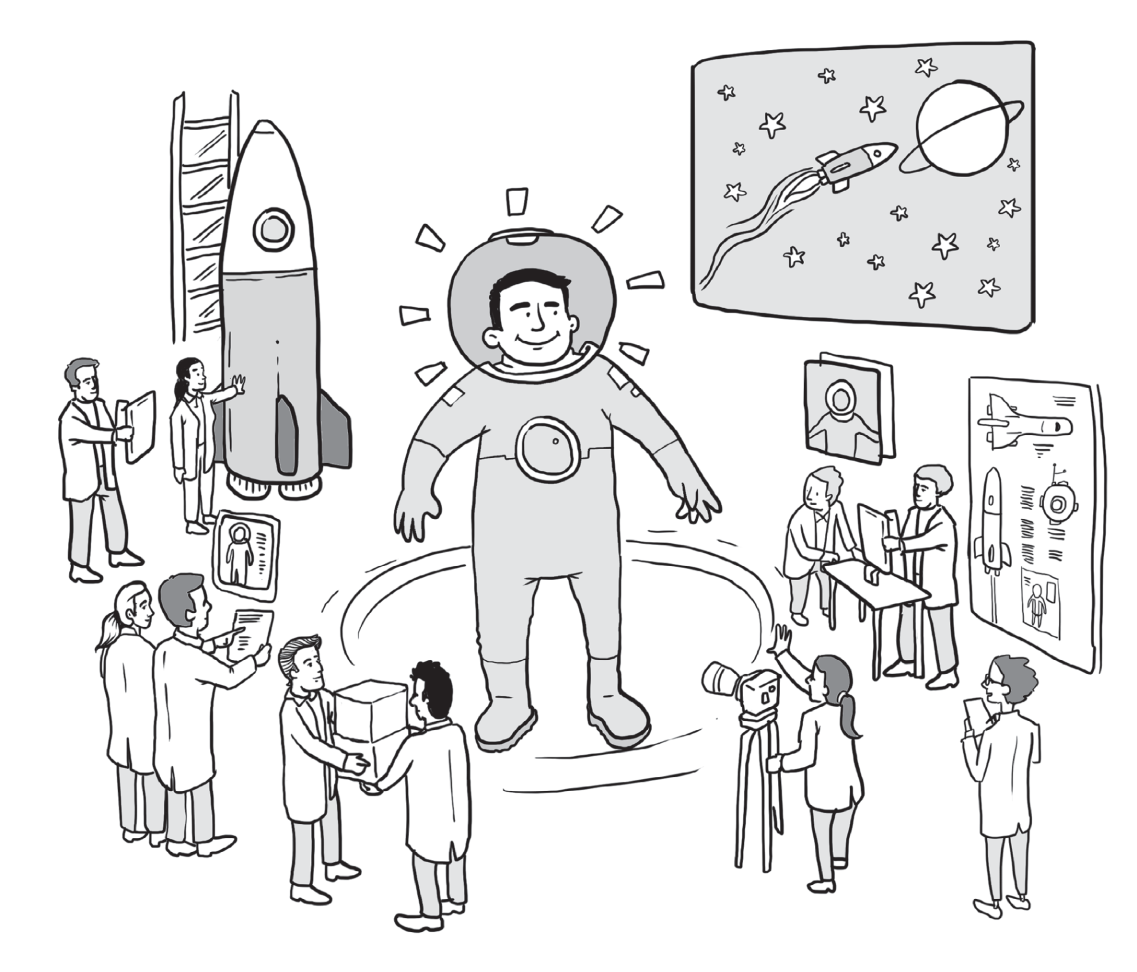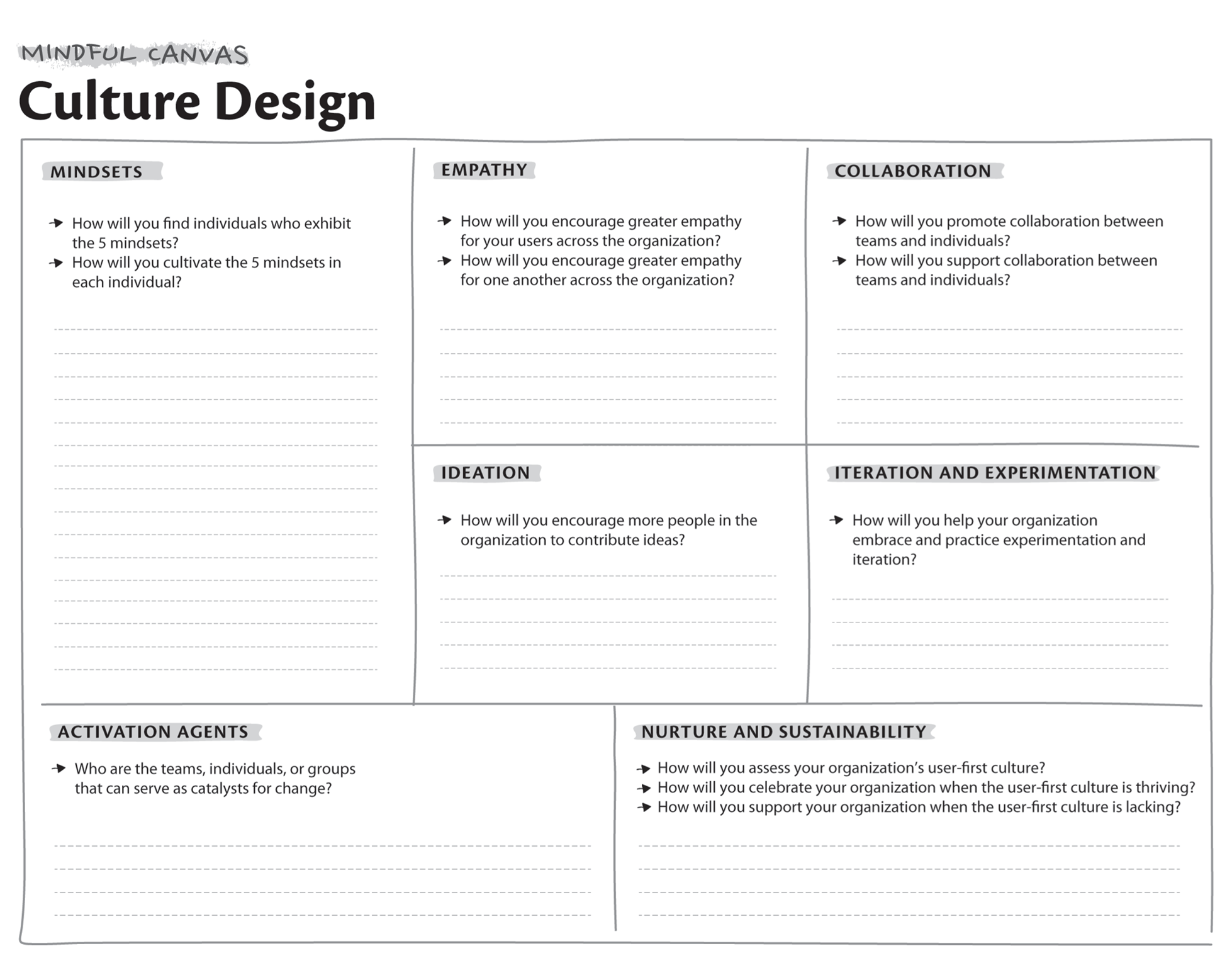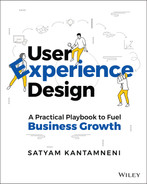CHAPTER 16
CULTURE DESIGN PLAY: How do I foster a user‐first organizational environment?
A user‐first culture drives innovation by placing an emphasis on delivering great experiences for users. Peter Drucker famously said, “Culture eats strategy for breakfast.” No matter how groundbreaking your strategy is, it will be held back if it is misaligned with your organizational culture, values, and mental attitudes. This play helps you create a culture that is aligned with your user‐centric strategy.

Who Are the Key players in the Culture Design play?
| ROLE | WHO’S INVOLVED | RESPONSIBILITIES |
|---|---|---|
 DRIVER | Chief experience officer |
|
 CONTRIBUTOR | Experience design team, individual teams across the organization |
|

THE HOW
To run an effective culture design play, you need to be mindful of:
1. Cultivating the Right MINDSETS in Individuals
A user‐first culture, first and foremost requires its individual practitioners, whether they engage in design or any other specialty, to possess the five mindsets described in Chapter 8: an experience mindset, a design mindset, a systems mindset, a business mindset, and an outcome mindset.
These are the mindsets that will activate your organization’s focus for its users, as well as kickstart an insatiable drive to continuously improve and develop a questioning spirit that challenges the status quo.
Cultivating and mastering these mindsets is a lifelong process. Find ways to incorporate them into all of your interactions, activities, and core processes, such as hiring (Chapter 21: “Hiring Play”), onboarding, cross‐functional collaboration (Chapter 36: “Cross‐Functional Collaboration Play”), and ideation.
Furthermore, they are the foundations for establishing the four cultural pillars all user‐first organizations must exhibit:
- High Empathy;
- Seamless Collaboration;
- Effective Ideation;
- Consistent Experimentation and iteration.
2. Fostering EMPATHY for the User and for Each Other
Empathy is the ability to adopt another person’s worldview and feel their pains and joys as if you were experiencing them yourself. Only when you deeply empathize with your user and understand their problems can you create solutions that drive real value. (Chapter 14: “User Empathy Play”).
This is why empathy is a critical cultural pillar for everyone in your organization—regardless of role or seniority—to adopt. Organizations need a high level of shared‐empathy maturity (Chapter 17: “Shared Empathy Play”) in order to successfully solve their users’ experience problems. Furthermore, it’s important to build empathy not only for your paying users but also for the other users in your organizational ecosystem. This will allow teams to collaborate more effectively and overcome challenges with minimal angst.
Empathy must be promoted on an individual and an organizational level. In your day‐to‐day practices, encourage teammates to suspend their own assumptions and listen deeply to what their users and coworkers are experiencing. Spread empathy by telling stories. Stories resonate and inspire people to take action.
3. Promoting COLLABORATION
Building great user experiences is a team effort. Every person in the organization must embrace collaboration and work together toward the company’s vision.
With the cultural pillar of collaboration, there’s no “us” vs. “them.” Departments are not siloed; instead, teams across the organization work together, exchange data, and meet on a regular basis to share knowledge about their users.
You should promote collaboration by bringing different departments together whenever possible, and encouraging participation in activities such as strategic planning, project kick‐offs, design reviews, ideation workshops, design handoffs, user research readouts, and retrospectives. Create a space where everyone’s multi‐disciplinary perspectives are welcome, and leverage these perspectives to find novel ways to solve the user’s problems.
You can share your user research findings with other departments, such as support, sales, or marketing. Learn from the data they have collected, as well, because their data might reveal a different perspective. As you continue to collaborate, you will have a substantial body of shared insights (Chapter 29: “Insights Curation Play”) with which your organization can make business and product‐related decisions.
4. Democratizing IDEATION
As Adam Grant found in his research on originality, “Being prolific actually increases originality because sheer volume improves your chances of finding novel solutions.”
A user‐first culture is constantly ideating.
The most important thing to remember about this third cultural pillar is that ideation is not exclusively reserved for designers. A company with high empathy and collaborative spirit means everyone in the organization deeply feels the user’s problems and is given the agency to contribute solutions to solve these problems.
Create channels beyond ideation sessions through which anyone can share their ideas. Broadcast these ideas, and provide opportunities for others to weigh in on them. Some ideas to consider include:
- Invite a new teammate, or a completely unrelated departmental teammate (that has built user empathy) to a design ideation as a guest attendee;
- Have a bulletin board (virtual or physical) where all the top user problems are identified, and anyone can share an idea or solution from their perspective;
- Have a company‐wide “idea box” that any team member can share whatever thoughts they have.
You can crowdsource ideas by holding organization‐wide hackathons or by creating an innovation lab where individuals can contribute and experiment on their ideas.
5. Supporting EXPERIMENTATION
Edison made 1,000 unsuccessful attempts—or, as we call them today, iterations—before he finally invented the working light bulb. Each unsuccessful attempt (or “failure”) gave him input to inform his design for the next iteration.
Edison’s approach offers an important takeaway many companies should internalize: failure needs to be a welcomed part of the journey to success. This is why the cultural pillar of experimentation and iteration is critical to building a user‐first culture that delivers great experiences. Breakthroughs come from continuous experimentation and iteration.
The cost of not running experiments is huge. It’s better to fail fast and learn from those failures early on than it is to fail after you’ve invested significant design and development resources into a product. Build cheap and fast prototypes, run experiments, get feedback from users, and embrace and learn from failures so you can improve on the final product.
6. Empowering the Necessary ACTIVATION AGENTS
To make a user‐first culture a reality, you need the right activation agents—the teams, individuals, or groups that can serve as catalysts for change.
- Leadership: A user‐first culture requires leaders who set the tone and lead from the front by placing an emphasis on ensuring and improving the user experience. They monitor experience metrics and are not afraid to dive deep if the data shows a deviation. They lead by example, taking customer support calls to better empathize with users and advocating for users in business strategy and product development. Leaders also provide the necessary support for the organization to ideate, collaborate, experiment, and empathize with users.
- Grassroots agents: Real cultural transformation happens when the new culture is anchored in the unspoken behaviors, mindsets, and norms of the individuals who make up the organization. Find catalysts who are passionate about the change to lead the cultural transformation and groom them to be agents of change who create a movement at the grassroots level.
7. The SUSTAINABILITY of Your User‐First Culture
An organization cannot sustain its culture without constant nurturing. This means the mindsets and cultural pillars must be incorporated and practiced in all aspects of your organization, consistently and over time.
Leverage your activation agents to propagate the culture and put it into practice through all of your organization’s activities. The culture should be reflected in how you hire and fire, how you ideate and develop, how you incentivize and reward teammates, and in how you make strategic decisions.
Use measurement methods such as the empathy scale (Chapter 17: “Shared Empathy Play”) to assess the pervasiveness of the mindsets and cultural pillars on an ongoing basis. Use these measures to celebrate individuals and teams when they strongly exhibit the user‐first culture, and provide more support and guidance to those who do not meet the mark.
IN ORDER TO MAXIMIZE THE VALUE OF THIS PLAY
- Keep in mind that it’s everyone’s job to build and reinforce an experience‐first culture; it’s not just the responsibility of one person (e.g. CEO) or department (e.g. human resources).
- Make it an organizational mandate to fund and invest in experiments, a core activity in user‐first culture.
- Hire based on mindsets and an ability to demonstrate alignment to the cultural pillars.
- Avoid a “big bang” cultural transformation. Focus on a few critical behavior changes, led by the people who are most passionate about the change.
- Create an environment in which there is psychological safety for people to openly share dissenting and critical views and in which they are valued for doing so.
- Build in appropriate incentives. A good experience‐first culture empowers individuals and encourages behaviors that reinforce the cultural pillars.
 RELATED PLAYS
RELATED PLAYS
- Chapter 14: “User Empathy Play”
- Chapter 17: “Shared Empathy Play”
- Chapter 21: “Hiring Play”
- Chapter 28: “Experience Metrics Play”
- Chapter 36: “Cross‐Functional Collaboration Play”
